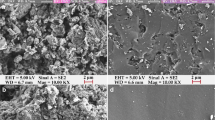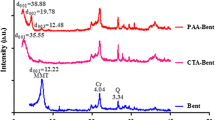Abstract
Model spent cetyltrimethylammonium bromide (CTMAB)-bentonite, and cetyl pyridinium chloride (CPC)-bentonite used for sorbing p-nitrophenol (PNP) from wastewater, as well as virgin CTMAB-bentonite and CPC-bentonite, were employed as the starting materials to prepare porous clay heterostructures (PCHs). The BET surface areas and total pore volumes of the PCHs based on these spent and virgin organobentonites (PNP-CTMAB-PCH, CTMAB-PCH, PNP-CPC-PCH and CPC-PCH) are 661.5 m2/g and 0.25 cm3/g, 690.4 m2/g and 0.27 cm3/g, 506.3 m2/g and 0.30 cm3/g, and 525.4 m2/g and 0.30 cm3/g, respectively. These values approximate those of activated carbon (AC), at 731.4 m2/g and 0.23 cm3/g, and are much larger than those of bentonite and CTMAB-bentonite, at 60.9 m2/g and 0.12 cm3/g, and 3.7 m2/g and 0.0055 m2/g, respectively. The PCHs have slightly higher adsorption capacities for benzene and CC14 than AC at higher relative pressures despite their comparatively lower benzene and CC14 adsorption capacity at lower relative pressures. The existence of PNP in organobentonites also enhances the volatile organic compounds (VOCs) adsorption capacity of PCHs at lower adsorbate concentrations, although some adsorption capacity is lost at higher concentrations. The hydrophobicity order of the adsorbents is: CTMAB-bentonite > AC > PCHs > bentonite. The micro- to mesoporous pore sizes, superior VOC adsorption properties, thermal stability to 750°C and hydrophobicity and negligible influences of PNP on PCHs make spent PNP-containing organobentonites ideal starting materials for synthesis of PCHs and especially attractive adsorbents for VOC sorption control.
Similar content being viewed by others
References
Ahenach, J., Cool, P. and Vansant, E.F. (2000) Enhanced Bronsted acidity created upon Al-grafting of porous clay heterostructures via aluminium acetylacetonate adsorption. Physical Chemistry Chemical Physics, 2, 5750–5755.
Barrer, R.M. (1989) Shape-selective sorbents based on clay minerals: a review. Clays and Clay Minerals, 37, 385–395.
Barrer, R.M. and Millington, A.D. (1967) Sorption and intracrystalline porosity in organo-clays. Journal of Colloid and Interface Science, 25, 359–372.
Barrett, E.P., Joyner, L.G. and Halenda, P.P. (1951) The determination of pore volume and area distributions in porous substances. I. Computations from nitrogen isotherms. Journal of the American Chemical Society, 73, 373–380.
Benjelloun, M., Cool, P. and Van Der Voort, P. (2002) Template extraction from porous clay heterostructures: influence on the porosity and the thermal stability of the materials. Physical Chemistry Chemical Physics, 4, 2818–2823.
Bering, B.P. and Serpinskiĭ, V.V. (1957) The computation of heat and entropy of adsorption from one adsorption isotherm. Doklady Akademii Nauk SSSR, 114, 1254–1256.
Boyd, S.A., Mortland, M.M. and Chiou, C.T. (1988) Sorption characteristics of organic compounds on hexadecyltrimethyl-ammonium-smectite. Soil Science Society of America Journal, 52, 652–657.
Ceollho, G.L.V., Augusto, F. and Pawliszyn, J. (2001) Desorption of ethyl acetate from adsorbent surfaces (organoclays) by supercritical carbon dioxide. Industrial & Engineering Chemistry Research, 40, 364–368.
Chen, S.G. and Yang, R.T. (1994) Theoretical basis for the potential theory adsorption isotherms. The Dubinin-Radushkevich and Dubinin-Astakhov equations. Langmuir, 10, 4244–4249.
Dubinin, M.M. (1966) Chemistry and Physics of Carbon. Marcel Dekker, New York, 51 pp.
Dubinin, M.M. and Astakhov, B.A. (1971) Development of theories on the volume filling of micropores during the adsorption of gases and vapors by microporous adsorbents. 1. Carbon adsorbents. Izvestiya Akademii Nauk SSR Series Khimiya, 1, 5–11.
Dubinin, M.M. and Stoechkli, H.F. (1980) Homogeneous and heterogeneous micropore structures in carbonaceous adsorbents. Journal of Colloid and Interface Science, 75, 34–42.
Galarneau, A., Barodawalla, A. and Pinnavaia, T.J. (1997) Porous clay heterostructures (PCH) as acid catalysts. Chemical Communications, 17, 1661–1662.
Galarneau, A., Barodawalla, A. and Pinnavaia, T.J. (1995) Porous clay heterostructures formed by gallery-templated synthesis. Nature, 374, 529–531.
Gregg, S.J. and Sing, K.S.W. (1982) Adsorption, Surface Area and Porosity. Academic Press, London, 25 pp.
Keyes, B.R. and Silcox, G.D. (1994) Fundamental study of the thermal desorption of toluene from montmorillonite clay particles. Environmental Science & Technology, 28, 840–849.
Langmuir, I. (1918) The adsorption of gases on plane surfaces of glass, mica and platinum. Journal of the American Chemical Society, 40, 1361–1403.
Lin, S.H. and Cheng, M.J. (2002) Adsorption of phenol and mchlorophenol on organobentonites and repeated thermal regeneration. Waste Management, 22, 595–603.
Marsh, K.N., editor (1987) Recommended Reference Materials for the Realization of Physicochemical Properties. Blackwell Scientific Publications, Oxford, 157 pp.
Ościk, J. (1982) Adsorption. Chichester, New York, 47 pp.
Pichowicz, M. and Mokaya, R. (2000) Porous clay heterostructures with enhanced acidity obtained from acid-activated clays. Chemical Communications, 20, 2100–2101.
Pinnavaia, T.J., Galarneau, A. and Barodawalla, A. (1998) Porous clay heterostructures prepared by gallery templated synthesis. US Patent 5,834,391.
Polverejan, M., Pauly, T.R. and Pinnavaia, T.J. (2000) Acidic porous clay heterostructures (PCH): Intragallery assembly of mesoporous silica in synthetic saponite clays. Chemistry of Materials, 12, 2698–2704.
Reucroft, R.J., Simpson, W.H. and Jonas, L.A. (1971) Sorption properties of activated carbon. The Journal of Organic Chemistry, 75, 3526–3531.
Smith, J.A. and Dinagalan, A. (1995) Sorption of nonionic organic contaminants to single and dual organic cation bentonites from water. Environmental Science & Technology, 29, 685–692.
Smith, J.A. and Jaffé, P.R. (1994) Benzene transport through landfill liners containing organophilic bentonite. Journal of Environmental Engineering, 120, 1559–1577.
Smith, J.A., Jaffé, P.R. and Chiou, C.T. (1990) Effect of ten quaternary ammonium cations on tetrachloromethane sorption to clay from water. Environmental Science & Technology, 24, 1167–1172.
Smith, J.A., Tuck, D.M., Jaffé, P.R. and Mueller, R.T. (1991) Organic Substances and Sediments in Water. Lewis, Chelsea, MI, 201 pp.
Stenzel, M.H. (1993) Removal of organics by activated carbon adsorption. Chemical Engineering Progress, 89, 36–43.
Tancrede, M., Wilson, R., Zeise, L. and Crouch, E.C. (1987) The carcinogenic risk of some organic vapors indoors: a theoretical survey. Atmospheric Environment, 21, 2187–2205.
Traina, S.J. and Onken, B.M. (1991) Cosorption of aromatic N-heterocycles and pyrene by smectites in aqueous solutions. Journal of Contaminant Hydrology, 7, 237–259.
Wexler, A.S. and Seinfeld, J.H. (1991) Second-generation inorganic aerosol model. Atmospheric Environment, 25A, 2731–2748.
Xie, W., Gao, Z., Pan, W.-P., Hunter, D., Singh, A. and Vaia, R. (2001) Thermal degradation chemistry of alkyl quaternary ammonium montmorillonite. Chemistry of Materials, 13, 2979–2990.
Zhao, X.S., Ma, Q. and Lu, G.Q. (Max). (1998) VOC removal: comparison of MCM-41 with hydrophobic zeolites and activated carbon. Energy & Fuels, 12, 1051–1054.
Zhu, L. and Chen, B. (2000) Sorption behavior of p-nitrophenol on the interface between anion-cation organobentonite and water. Environmental Science & Technology, 34, 2997–3002.
Zhu, L. and Su, Y. (2002) Benzene vapors sorption by organobentonites from ambient air. Clays and Clay Minerals, 50, 421–427.
Author information
Authors and Affiliations
Corresponding author
Rights and permissions
About this article
Cite this article
Zhu, L., Tian, S. & Shi, Y. Adsorption of volatile organic compounds onto porous clay heterostructures based on spent organobentonites. Clays Clay Miner. 53, 123–136 (2005). https://doi.org/10.1346/CCMN.2005.0530202
Received:
Revised:
Published:
Issue Date:
DOI: https://doi.org/10.1346/CCMN.2005.0530202




